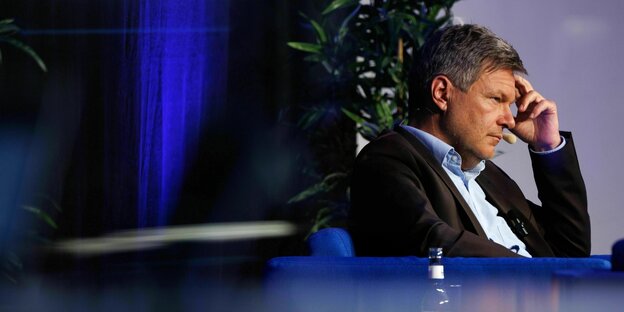Minister Havek comments calmly on the temporary refusal of CDU leader Merz, who says other Greens would rather join the opposition than join him in government.

Robert Harbeck at the demonstration of the “Citizen Dialogue of NOZ” in Osnabrück on September 18, 2024 as part of the North-West Tour Photo: Friso Gentsch/dpa
Osnabrück/Steinfurt Taz | On Wednesday evening, Robert Habeck looks at the federal election campaign. The vice chancellor is in Osnabrück for a Q&A with local newspaper Citizen. Nose Invited to the event, he talks about a question he believes will be crucial in the coming year: “Do we want the country to be strong enough to solve problems, or do we just yell at each other?”
It is clear where the candidate for chancellor sees himself: the Greens are the “party of problem solving”. If this is followed, then the big question will arise after the elections at the latest. Who else would he like to solve problems with? Nobody wants another traffic light. 0% of the respondents to the “ZDF Political Index” chose this as their preferred constellation, and in any case the SPD, Greens and FDP will not win a majority. According to the current survey, two alternatives are realistic: the coalition wins the elections and can choose to govern with the SPD or the Greens.
This week showed once again where the CDU and CSU’s preferences are headed. Markus Söder once again ruled out Black and Green. “The CSU will prevent this,” he said. But above all, according to Friedrich Merz, who was just announced as the chancellor candidate, such a coalition is impossible “in today’s terms.” Merz has never been a friend of the Greens and with his announcement he is at least leaving the back door open. But in the meantime he has shown himself to be more open to Black and Green.
Robert Habeck was calm when asked about it during a company visit to North Rhine-Westphalia on Thursday. “I took note. It seems a bit 90s to me,” he said. “I don’t seek any affection from the federation.”
Undecided and unpopular
On the one hand, there are reasons for calm. There are other signs of coalition. The premiers of North Rhine-Westphalia and Schleswig-Holstein, Hendrik Wüst and Daniel Günther, have governed successfully with the Greens. This week, they met for a joint cabinet meeting. “We showed that black and green can work well together,” Günther said. They are not currently setting the tone in the coalition. But what will happen between now and the federal elections is unpredictable.
On the other hand, there is public opinion against the black-green coalition, at least for now, according to an Allensbach poll conducted on Thursday. Paz Only 12% of those surveyed reported that they were in favor of such a union. Only the constellations with Traffic Light, Jamaica and BSW were less popular. The most popular was black and red, at 29%.
Of course, moods can change again. But this rarely happens on its own. This creates additional campaign work for the Greens: reminding people of the last grand coalition and its consequences. Or rather, convincing a society tired of change that a coalition of two structurally conservative parties is not right. Habeck’s talk of a ‘problem-solving party’ is not accidental.
Finally, there could be another obstacle for Black-Green. There is the Green Party, which, tired of being the opposition in 2021, does not want to return to power at any cost. A better opposition than Merz: After all the compromises of the past years, some say this could be an opportunity. A chance to find yourself again, to make your name known with your own issues, to have a bigger voice in the discourse. That is what the coalition is doing now. And how the Greens also had a brief success at the traffic lights.



